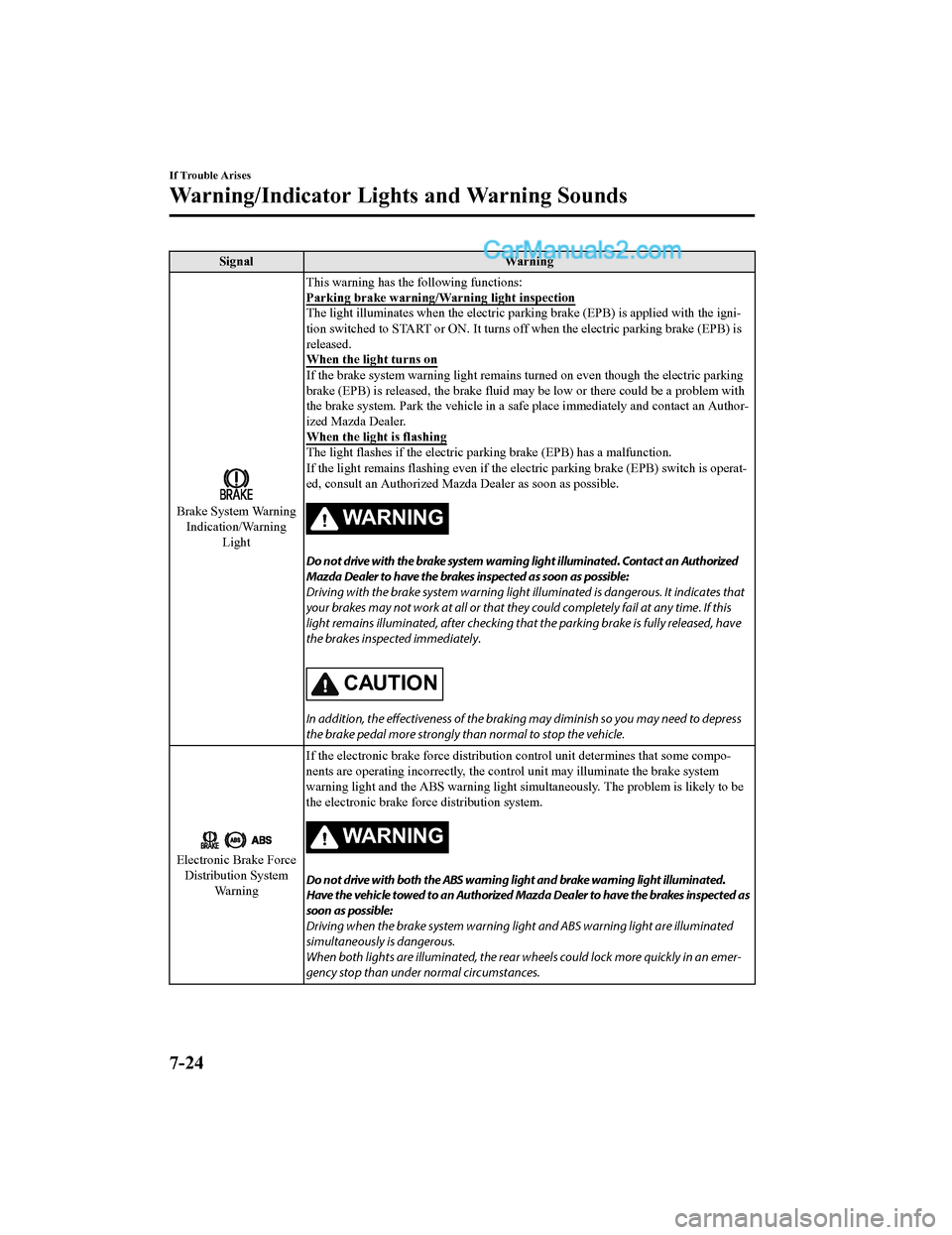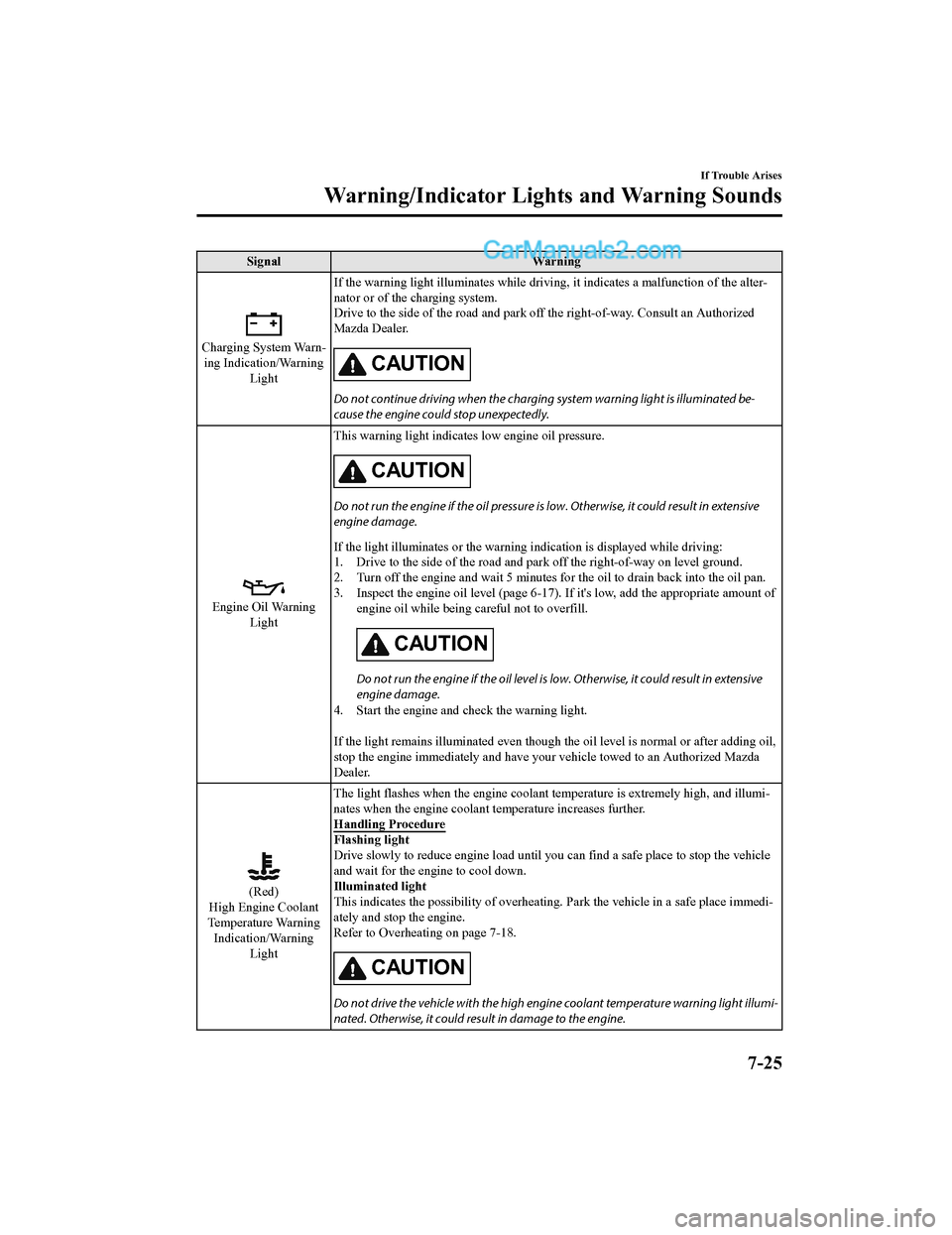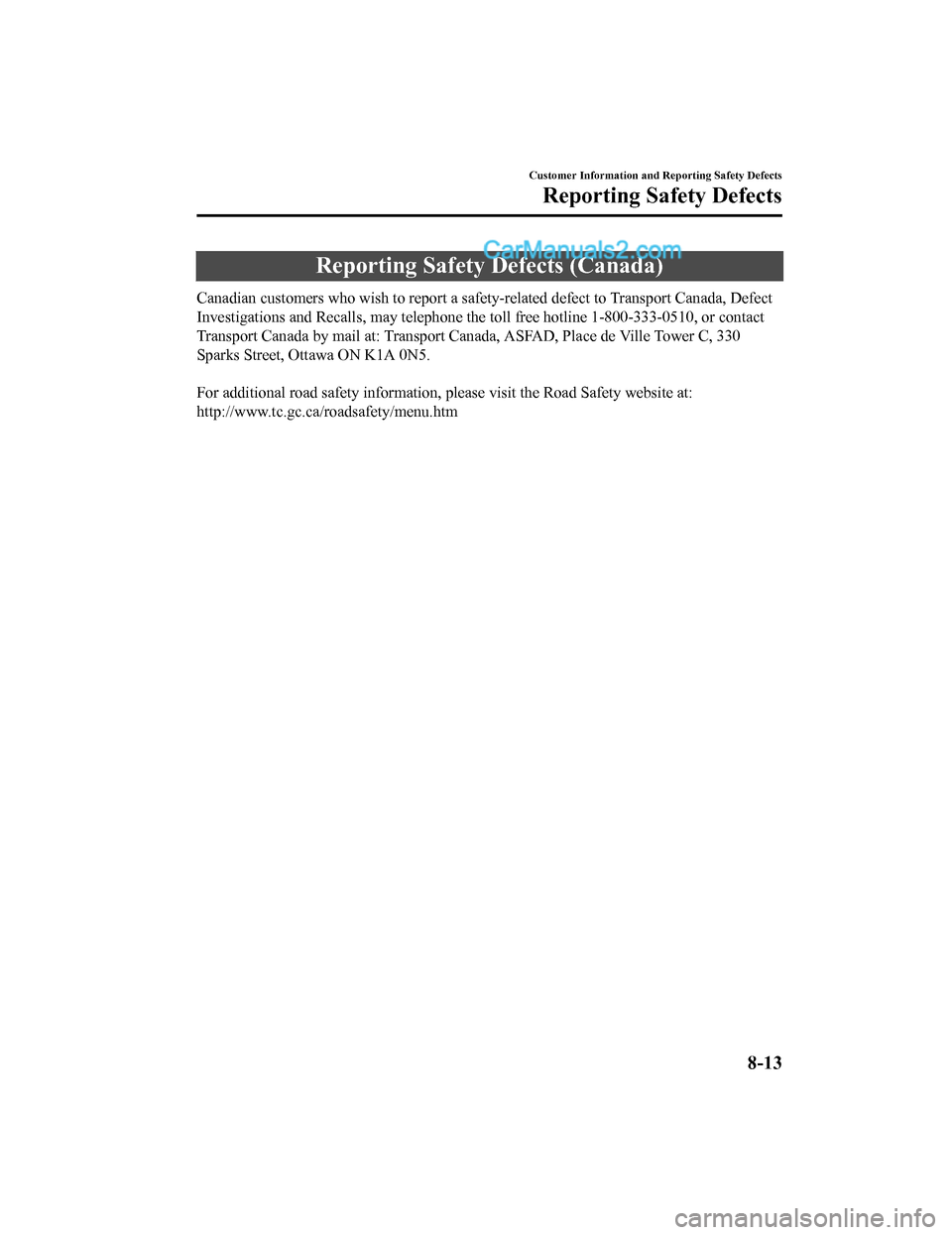tow MAZDA MODEL CX-5 2018 (in English) Owner's Guide
[x] Cancel search | Manufacturer: MAZDA, Model Year: 2018, Model line: MODEL CX-5, Model: MAZDA MODEL CX-5 2018Pages: 628, PDF Size: 82.38 MB
Page 510 of 628

Parking in an Emergency
The hazard warning lights should always
be used when you stop on or near a
roadway in an emergency.
The hazard warning lights warn other
drivers that your vehicle is a traffic hazard
and that they must take extreme caution
when near it.
Depress the hazard warning flasher and all
the turn signals will flash. The hazard
warning indicator lights in the instrument
cluster flash simultaneously.
NOTE
•The turn signals do not work when the
hazard warning lights are on.
•Check local regulations about the use of
hazard warning lights while the vehicle
is being towed to verify that it is not in
violation of the law.
If Trouble Arises
Parking in an Emergency
7-2
CX-5_8GN5-EA-17J_Edition1 2017-8-18 12:58:27
Page 525 of 628

Starting a Flooded Engine
If the engine fails to start, it may be
flooded (excessive fuel in the engine).
Follow this procedure:
1. If the engine does not start within fiveseconds on the first try, wait ten
seconds and try again.
2. Make sure the parking brake is on.
3. Depress the accelerator all the way and hold it there.
4. Depress the brake pe dal, then press the
push button start. If the engine starts,
release the accelerator immediately
because the engine will suddenly rev
up.
5. If the engine fails to start, crank it without depressing the accelerator.
If the engine still does not start using the
previous procedure, have your vehicle
inspected by an Authorized Mazda Dealer.
Push-Starting
Do not push-start your Mazda.
WA R N I N G
Never tow a vehicle to start it:
Towing a vehicle to start it is dangerous.
The vehicle being towed could surge
forward when its engine starts, causing the
two vehicles to collide. The occupants
could be injured.
NOTE
You cannot start a vehicle with an
automatic transaxle by pushing it.
If Trouble Arises
Emergency Starting
7-17
CX-5_8GN5-EA-17J_Edition1 2017-8-18 12:58:27
Page 528 of 628

Towing Description
We recommend that towing be done only
by an Authorized Mazda Dealer or a
commercial tow-truck service.
Proper lifting and towing are necessary to
prevent damage to the vehicle. Particularly
when towing an AWD vehicle, where all
the wheels are connected to the drive train,
proper transporting of the vehicle is
absolutely essential to avoid damaging the
drive system. Government and local laws
must be followed.
Wheel dollies
A towed 2WD vehicle should have its
drive wheels (front wheels) off the ground.
If excessive damage or other conditions
prevent this, use wheel dollies.
When towing a 2WD vehicle with the rear
wheels on the ground, release the parking
brake.
Refer to Electric Parking Brake (EPB) on
page 4-65.
A towed AWD vehicle must have all its
wheels off the ground.
WA R N I N G
Always tow an AWD vehicle with all four
wheels off the ground:
Towing an AWD vehicle with either the
front or rear wheels on the ground is
dangerous as the drive train could be
damaged, or the vehicle could trail away
from the tow truck and cause an accident.
If the drive train has been damaged,
transport the vehicle on a flatbed truck.
CAUTION
Do not tow the vehicle pointed backward
with driving wheels on the ground. This
may cause internal damage to the
transaxle.
If Trouble Arises
Emergency Towing
7-20
CX-5_8GN5-EA-17J_Edition1 2017-8-18 12:58:27
Page 529 of 628

Do not tow with sling-type equipment.
This could damage your vehicle. Use
wheel-lift or
flatbed equipment.
If the electric parking brake (EPB) cannot
be released when towing the vehicle,
transport the vehicle with all front and
rear wheels raised
off the ground as
shown in the figure. If the vehicle is
towed without raising the wheels off the
ground, the brake system could be
damaged.
Wheel dollies
Tiedown Hooks*
CAUTION
Do not use the front and rear tiedown
eyelets for towing the vehicle.
They have been designed only for securing
the vehicle to a transport vessel during
shipping.
Using the eyelets for any other purpose
could result in the vehicle being damaged.
▼ Tiedown Hooks
1. Remove the tiedown eyelet and the lug
wrench from the luggage compartment
(page 7-3).
2. Wrap a flathead screwdriver or similar
tool with a soft c loth to prevent
damage to a painted bumper, and open
the cap located on the front or rear
bumper.
Front
If Trouble Arises
Emergency Towing
*Some models.7-21
CX-5_8GN5-EA-17J_Edition1 2017-8-18 12:58:27
Page 530 of 628

Rear
Jack lever
CAUTION
Do not use excessive force as it may
damage the cap or scratch the painted
bumper surface.
NOTE
Remove the cap completely and store it
so as not to lose it.
3. Securely install the tiedown eyelet
using the lug wrench.
Front
Lug wrench
Tiedown
eyelet
Rear
Tiedown eyelet
Lug wrench
4. Hook the tying ro pe to the tiedown
eyelet.
CAUTION
If the tiedown eyelet is not securely
tightened, it may loosen or disengage
from the bumper when tying the
vehicle. Make sure that the tiedown
eyelet is securely tightened to the
bumper.
If Trouble Arises
Emergency Towing
7-22
CX-5_8GN5-EA-17J_Edition1 2017-8-18 12:58:27
Page 532 of 628

SignalWarning
Brake System Warning
Indication/Warning Light This warning has the following functions:
Parking brake warning/Warning light inspection
The light illuminates when the electric parking brake (EPB) is
applied with the igni-
tion switched to START or ON. It turns off when the electric pa rking brake (EPB) is
released.
When the light turns on
If the brake system warning light remains turned on even though the electric parking
brake (EPB) is released, the brak e fluid may be low or there could be a problem with
the brake system. Park the vehicle in a safe place immediately and contact an Author-
ized Mazda Dealer.
When the light is flashing
The light flashes if the electric parking brake (EPB) has a mal function.
If the light remains flashing ev en if the electric parking brake (EPB) switch is operat-
ed, consult an Authorized Mazd a Dealer as soon as possible.
WARNING
Do not drive with the brake system warning light illuminated. Contact an Authorized
Mazda Dealer to have the brakes inspected as soon as possible:
Driving with the brake system warning light illuminated is dangerous. It indicates that
your brakes may not work at all or that they could completely fail at any time. If this
light remains illuminated, after checking that the parking brake is fully released, have
the brakes inspected immediately.
CAUTION
In addition, the effectiveness of the braking may diminish so you may need to depress
the brake pedal more strongly than normal to stop the vehicle.
Electronic Brake Force Distribution System Wa r n i n g If the electronic brake force di
stribution control unit determines that some compo-
nents are operating incorrectly , the control unit may illuminate the brake system
warning light and the ABS warni ng light simultaneously. The problem is likely to be
the electronic brake force distribution system.
WARNING
Do not drive with both the ABS warning light and brake warning light illuminated.
Have the vehicle towed to an Authorized Mazda Dealer to have the brakes inspected as
soon as possible:
Driving when the brake system warning li ght and ABS warning light are illuminated
simultaneously is dangerous.
When both lights are illuminate d, the rear wheels could lock more quickly in an emer‐
gency stop than under normal circumstances.
If Trouble Arises
Warning/Indicator Lights and Warning Sounds
7-24
CX-5_8GN5-EA-17J_Edition1 2017-8-18 12:58:27
Page 533 of 628

SignalWarning
Charging System Warn-
ing Indication/Warning Light If the warning light illuminates
while driving, it indicates a malfunction of the alter-
nator or of the charging system.
Drive to the side of the road and park off the right-of-way. Co nsult an Authorized
Mazda Dealer.
CAUTION
Do not continue driving when the charging system warning light is illuminated be‐
cause the engine could stop unexpectedly.
Engine Oil Warning Light This warning light indicates
low engine oil pressure.
CAUTION
Do not run the engine if the oil pressure is low. Otherwise, it could result in extensive
engine damage.
If the light illuminates or the warning indication is displayed while driving:
1. Drive to the side of the road and park off the right-of-way o n level ground.
2. Turn off the engine and wait 5 minutes for the oil to drain back into the oil pan.
3. Inspect the engine oil level (page 6-17). If it's low, add th e appropriate amount of
engine oil while being careful not to overfill.
CAUTION
Do not run the engine if the oil level is low. Otherwise, it could result in extensive
engine damage.
4. Start the engine and check the warning light.
If the light remains illuminated even though the oil level is normal or after adding oil,
stop the engine immediately and have your vehicle towed to an Authorized Mazda
Dealer.
(Red)
High Engine Coolant
Temperature Warning
Indication/Warning
Light The light flashes when the engine coolant temperature is extrem
ely high, and illumi-
nates when the engine coolant temperature increases further.
Handling Procedure
Flashing light
Drive slowly to reduce engine l oad until you can find a safe place to stop the vehicle
and wait for the engine to cool down.
Illuminated light
This indicates the possibility of overheating. Park the vehicle in a safe place immedi-
ately and stop the engine.
Refer to Overheating on page 7-18.
CAUTION
Do not drive the vehicle with the high engi ne coolant temperature warning light illumi‐
nated. Otherwise, it could resu lt in damage to the engine.
If Trouble Arises
Warning/Indicator Lights and Warning Sounds
7-25
CX-5_8GN5-EA-17J_Edition1 2017-8-18 12:58:27
Page 569 of 628

Reporting Safety Defects (Canada)
Canadian customers who wish to report a safety-related defect to Transport Canada, Defect
Investigations and Recalls, may telephone the toll free hotline 1-800-333-0510, or contact
Transport Canada by mail at: Transport Canada, ASFAD, Place de Ville Tower C, 330
Sparks Street, Ottawa ON K1A 0N5.
For additional road safety information, please visit the Road S afety website at:
http://www.tc.gc.ca /roadsafety/menu.htm
Customer Information and Reporting Safety Defects
Reporting Safety Defects
8-13
CX-5_8GN5-EA-17J_Edition1 2017-8-18 12:58:27
Page 589 of 628

▼Safety Practices
The way you drive has a great deal to do with your tire mileage
and safety. So cultivate
good driving habits for your own benefit.
•Observe posted speed limits and drive at speeds that are safe f or the existing weather
conditions
•Avoid fast starts, stops and turns
•Avoid potholes and objects on the road
•Do not run over curbs or hit the tire against the curb when parking
CAUTION
If you feel a sudden vibration or ride disturbance while driving or you suspect your tire or
vehicle has been damaged, immediately reduce yo ur speed. Drive with caution until you can
safely pull off the road. Stop and inspect the tire for damage. If the tire is under-inflated or
damaged, deflate it, remove the tire and rim and replace it with your spare tire. If you cannot
detect a cause, have the vehicle towed to the ne arest vehicle or tire dealer to have the vehicle
inspected.
Customer Information and Reporting Safety Defects
Tire Information (U.S.A.)
8-33
CX-5_8GN5-EA-17J_Edition1 2017-8-18 12:58:27
Page 592 of 628

Cargo Weight includes all weight added to the Base Curb Weight, including c argo and
optional equipment. When towing, trailer tongue load or king pi n weight is also part of
cargo weight.
The cargo weight limit decreases depending on the number of veh icle occupants. The cargo
weight limit can be calculated by subtracting the total weight of the vehicle occupants from
the “combination weight of occupants and cargo should never exc eed” value on the tire
label.
Examples: Based on a single occupant weight of 68 kg (150 lbs), and a value of 385 kg (849
lbs) for the “combination weight of occupants and cargo should never exceed”:
The cargo weight limit with one occupant is 385 kg (849 lbs) - 68 kg (150 lbs) = 317 kg
(699 lbs)
The cargo weight limit with two occupants is 385 kg (849 lbs) - (68 × 2) kg ( (150 × 2)
lbs) = 249 kg (549 lbs)
If the weight of the occupant increases, the cargo weight limit decreases by that much.
GAW (Gross Axle Weight) is the total weight placed on each axle (front and rear) -
including vehicle curb weight and all payload.
GAWR (Gross Axle Weight Rating) is the maximum allowable weight that can be carried
by a single axle (front or rear). These numbers are shown on the Safety Compliance
Certification Label located on the driver's door frame or door pillar. The total load on
each axle must never exceed its GAWR.
GVW
GVW (Gross Vehicle Weight) is the Vehicle Curb Weight cargo passengers.
Customer Information and Reporting Safety Defects
Tire Information (U.S.A.)
8-36
CX-5_8GN5-EA-17J_Edition1 2017-8-18 12:58:27